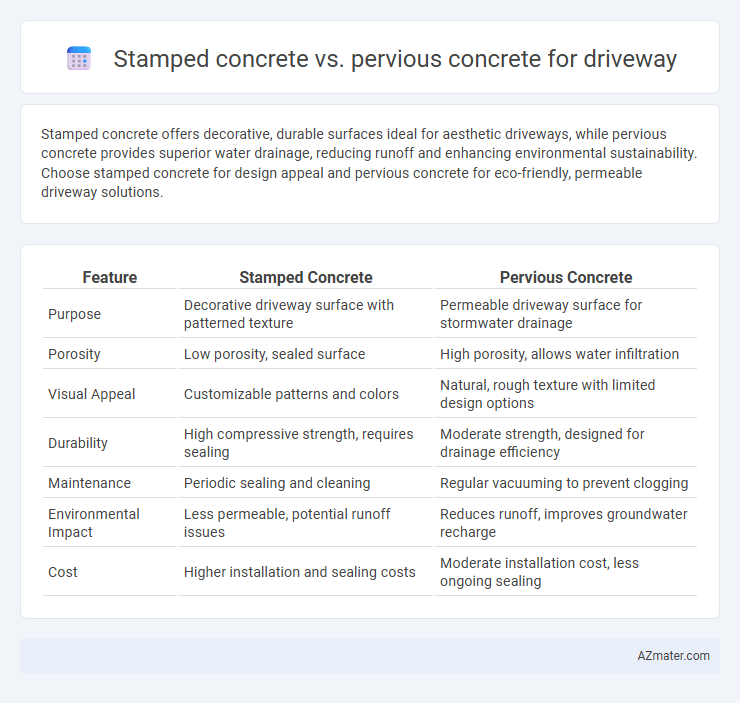Stamped concrete offers decorative, durable surfaces ideal for aesthetic driveways, while pervious concrete provides superior water drainage, reducing runoff and enhancing environmental sustainability. Choose stamped concrete for design appeal and pervious concrete for eco-friendly, permeable driveway solutions.
Table of Comparison
| Feature | Stamped Concrete | Pervious Concrete |
|---|---|---|
| Purpose | Decorative driveway surface with patterned texture | Permeable driveway surface for stormwater drainage |
| Porosity | Low porosity, sealed surface | High porosity, allows water infiltration |
| Visual Appeal | Customizable patterns and colors | Natural, rough texture with limited design options |
| Durability | High compressive strength, requires sealing | Moderate strength, designed for drainage efficiency |
| Maintenance | Periodic sealing and cleaning | Regular vacuuming to prevent clogging |
| Environmental Impact | Less permeable, potential runoff issues | Reduces runoff, improves groundwater recharge |
| Cost | Higher installation and sealing costs | Moderate installation cost, less ongoing sealing |
Introduction to Stamped Concrete and Pervious Concrete
Stamped concrete for driveways offers a durable, decorative surface that mimics natural materials like stone, brick, or wood while providing strength and low maintenance. Pervious concrete is engineered with high porosity, allowing water to pass through and reduce runoff, making it an eco-friendly option for sustainable drainage systems. Selecting between stamped and pervious concrete depends on factors such as aesthetic preference, environmental impact, and site-specific drainage needs.
Key Differences Between Stamped and Pervious Concrete
Stamped concrete features decorative patterns and textures that mimic natural stone, offering aesthetic appeal and surface durability ideal for driveways. Pervious concrete provides enhanced water drainage by allowing rainwater to permeate through its porous structure, significantly reducing runoff and promoting groundwater recharge. While stamped concrete requires sealing to prevent stains and water damage, pervious concrete emphasizes environmental benefits with increased permeability but may have lower compressive strength compared to traditional stamped surfaces.
Aesthetic Appeal and Design Options
Stamped concrete offers a wide range of design options with patterns and colors that mimic natural stone, brick, or wood, enhancing the driveway's aesthetic appeal with intricate textures and customized finishes. Pervious concrete provides a more natural, muted look with limited design versatility but excels in functionality by allowing water drainage and supporting sustainable landscaping. Driveway owners seeking visually striking, customizable surfaces often prefer stamped concrete, while those prioritizing eco-friendly design and permeability lean towards pervious concrete.
Durability and Lifespan Comparison
Stamped concrete offers high durability with resistance to heavy traffic and weather conditions, typically lasting 25 to 30 years when properly maintained. Pervious concrete, designed for water permeability, has a shorter lifespan of 15 to 20 years due to potential clogging and reduced structural strength under heavy loads. Choosing stamped concrete ensures a longer-lasting driveway with superior wear resistance, while pervious concrete supports sustainable drainage but demands more frequent upkeep.
Installation Process and Timeline
Stamped concrete installation involves pouring a concrete slab, applying color hardeners, and imprinting patterns while the concrete is still wet, typically taking 2 to 3 days including curing. Pervious concrete requires a similar pouring process but demands careful placement and compaction to maintain its porous structure, with curing times often extended to 7 days to ensure proper strength and permeability. Both methods require skilled labor, but pervious concrete installation involves additional steps for moisture management and quality control, impacting the overall timeline and complexity.
Maintenance Requirements for Each Type
Stamped concrete driveways require regular sealing every 2-3 years to prevent fading, cracking, and moisture damage, along with periodic cleaning to remove dirt and debris. Pervious concrete driveways demand less frequent sealing but need routine inspections to ensure the porous structure remains unclogged, often necessitating vacuum sweeping or pressure washing to maintain optimal drainage. Proper maintenance of stamped concrete emphasizes surface protection and aesthetics, whereas pervious concrete focuses on preserving permeability to avoid water pooling and erosion issues.
Environmental Impact and Sustainability
Stamped concrete offers durability but tends to have a higher environmental impact due to its impervious nature, leading to increased stormwater runoff and potential groundwater contamination. Pervious concrete enhances sustainability by allowing water infiltration, reducing runoff, and promoting groundwater recharge, which mitigates flooding and improves water quality. Choosing pervious concrete for driveways supports eco-friendly urban drainage systems and aligns with green building standards like LEED certification.
Cost Analysis: Upfront and Long-Term
Stamped concrete typically involves higher upfront costs due to intricate patterns and color treatments, averaging between $8 to $18 per square foot. Pervious concrete, designed for water permeability and environmental benefits, generally costs $7 to $12 per square foot but may require specialized installation. Long-term expenses for stamped concrete include maintenance such as sealing every 2-3 years to prevent cracking, while pervious concrete often incurs lower maintenance costs but may need periodic cleaning to avoid clogging, impacting overall lifecycle cost efficiency.
Performance in Various Weather Conditions
Stamped concrete offers superior durability and aesthetic appeal, with excellent resistance to freeze-thaw cycles, making it suitable for regions with harsh winters. Pervious concrete excels in managing stormwater through high permeability, reducing runoff and flooding risks in heavy rainfall areas, but may have lower abrasion resistance under vehicle traffic. The choice depends on climate priorities: stamped concrete performs better in cold weather durability, while pervious concrete enhances water drainage in wet conditions.
Choosing the Right Concrete for Your Driveway
Stamped concrete offers aesthetic versatility with customizable patterns and colors, making it ideal for enhancing curb appeal. Pervious concrete provides excellent water drainage by allowing rainwater to pass through, reducing runoff and promoting groundwater recharge. Selecting the right concrete depends on whether your priority is decorative appeal or environmental sustainability combined with effective stormwater management.

Infographic: Stamped concrete vs Pervious concrete for Driveway
 azmater.com
azmater.com